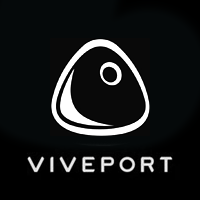Mona Lisa Beyond The Glass
• 4-star rating
• PCVR
• Art, Education, Free, Museums
• Comfortable, Roomscale, Stationary

Spending some time with World's most famous painting, in the World's most visted museum is never going to be a solitary or tranquil experience. Probably not a great one either if the only glimpses of the Mona Lisa you get are between the heads of an admiring crowd of which you are part. Nor is the view helped by the bulletproof glass protecting the painting, making your experience with Leonardo Da Vinci's masterwork even more distant.
Unless you polish the floors of the Louvre for a living you're probably unlikely to ever get close to the Mona Lisa. The best way to appreciate the painting may be this Wikipedia version which offers download dimensions up to a massive 7,479 x 11,146 pixels, which is a size equivalent to a stack of 40 high definition TVs. Yet not even this will be able to capture the soft-focus effect of the real thing, achieved by the application of incredibly thin layers of oil paint that Da Vinci painstakingly built up over several months.
Despite advances in technology, viewing works of art in virtual reality is still a poor cousin compared to the real thing. Even modern flat screen monitors are much better viewing experiences. However there are things that only VR can achieve, as Mona Lisa Beyond The Glass demonstrates.
 3D recreation of the Mona Lisa model and surroundings.
3D recreation of the Mona Lisa model and surroundings.Beginning at the Louvre's entrance courtyard before directing you into a deserted Grand Gallerie, it feels like you have the keys to the whole Louvre. That's not the case though as your explorations are limited just one further location - the salle des Etats (Estate Room) in which the Mona Lisa is located. Before heading leaving the Gallarie the app prompts you to look over four other Leonardo Da Vinci paintings, which we found to a be less than ideal experience because of low graphic fidelity. For example, here's a comparison between a screenshot of La Belle Ferronnière in virtual reality (left) compared with the version available on Wikipedia (right).
Teleporting to the salle des Etats unceremoniously drops you straight into the middle of an enormous room with midnight blue walls, three of which are adorned with richly colored oil paintings, though the program won't even let us get close to these. On the fourth wall is just one small painting, hanging behind thick sheet of glass. Pressing 'start' at this point will begin the main event of this experience - a narrated introduction to the Mona Lisa followed by the reveal of an animated, breathing three dimensional model Lisa del Giocondo.
The engaging narrative continues, describing the painting's creation and providing interpretation of it's details. Eventually the background of the painting also fades away, to be replaced by a fanciful 3D recreation the landscape beyond the portrait. After some further interactive interpretation, there's even a further scene, but we will leave that for viewers to discover themselves.

The Louvre's Grand Gallerie in Virtual Reality.
Mona Lisa Beyond The Glass will likely engage an audience who may not be usually drawn to art and art history, and that alone makes it a worthwhile production. The experience achieves this in an entertaining and polished way, though we lament the way it teases many other of the museum's treasures without letting us get close to them. Some will call this VR experience a novelty that imparts less information than an the Wikipedia article, and they'd be right, but a novel experience will often remain in the minds of the audience longer than reading a web page.
✅ Polished experience with good graphics.
✅ Engaging and entertaining narrative journey.
❌ No close-up of the real thing.
❌ Can't get close to other Louvre treasures.
• Languages: English, French, Japanese, Mandarin, Spanish


